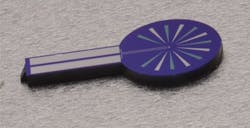Optimized photon-counting detector with no dark counts enables quantum-mechanics experiment
Gaithersburg, MD--To conduct an important quantum-mechanics experiment, an international team of researchers had to create an extremely efficient photon-counting detector; the type they chose was a transition-edge sensor (TES), which has no dark counts whatsoever—a characteristic required for their precision experiment. The detector was devised by scientists at the National Institute of Standards and Technology Physical Measurement Laboratory (NIST PML), a member of the scientific team.
The work, reported last month in Nature, eliminates the last remaining potential loophole to a quantum-mechanical interpretation of results from observations of pairs of entangled photons. The problem, related to the Bell inequality and known as the "detection-efficiency/fair sampling loophole," results from the fact that, until now, the detectors used in photon-based experiments on a certain test for the Bell inequality have captured an insufficiently large fraction of photons, and the photon sources have been insufficiently efficient.
The new research, conducted at the Institute for Quantum Optics and Quantum Communication in Austria, closes the loophole by using improved photon sources (spontaneous parametric down-conversion in a Sagnac configuration) and ultrasensitive detectors provided by the Single Photonics and Quantum Information project in PML’s Quantum Electronics and Photonics Division.
Up to 98% single-photon detection efficiency
The TES photon detectors provide single-photon detection efficiencies as high as 98%. Each unit, about 25 µm x 25 µm, contains a tungsten film 20 nm thick that is kept at a temperature (about 100 mK) right at the transition between the superconducting state and normal resistance. A small bias voltage is applied across the sensor. When an incident photon from a coupled optical fiber deposits energy in the tungsten film, the temperature rises, the resistance of the tungsten increases substantially, and the resulting current drop signals detection.
Not only are TES detectors highly efficient, but they are intrinsically free of spurious dark counts (detection signals that occur when no photon is present). "This combination," the researchers note, "is imperative for an experiment in which no correction of count rates can be tolerated."
NIST's packaging is key
For the experiment, Sae Woo Nam, project leader for Single Photonics and Quantum Information, and colleagues provided a set of TES detectors optimized for the 810 nm photons produced by the source. Each was carefully constructed to minimize losses that can result from packaging and source-to-detector fiber coupling. "Our packaging is one of the key enabling technologies that make the experiment possible," Nam says.
If recent successes are predictive of the future, PML's TES technology will continue to provide state-of-the-art capabilities to numerous other experiments and research projects.
"The single-photon detectors developed by the NIST team have proven to be a game-changer for the quantum information research community around the world," says Robert Hickernell, Acting Chief of the Quantum Electronics and Photonics Division.
About the Author
John Wallace
Senior Technical Editor (1998-2022)
John Wallace was with Laser Focus World for nearly 25 years, retiring in late June 2022. He obtained a bachelor's degree in mechanical engineering and physics at Rutgers University and a master's in optical engineering at the University of Rochester. Before becoming an editor, John worked as an engineer at RCA, Exxon, Eastman Kodak, and GCA Corporation.

